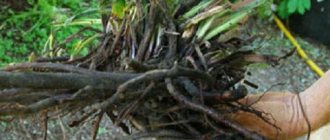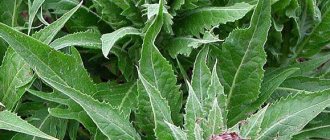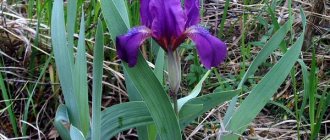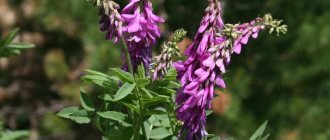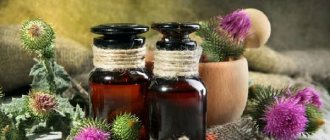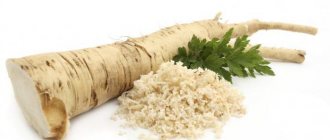Useful Features
To understand how comfrey root benefits the body, you should analyze its composition. Organic acids, tannins, and glycosides were found in it.
Alkaloids, mucus, starch, and polysaccharides are present. Included in the structural formula are resins, allantoin, vitamin B12, and carbohydrates. Flavonoids and essential oils are beneficial. Medicinal properties:
- hemostatic;
- painkillers;
- astringents;
- antitumor;
- anti-inflammatory;
- enveloping;
- decongestants;
- hypotensive;
- antitumor;
- bactericidal;
- expectorants;
- regenerating.
Larkspur rhizome, due to the presence of allantoin in the structural formula, promotes the rapid restoration of bone tissue, which led to its use in the elimination of musculoskeletal pathologies. Indications:
- arthritis;
- sprains;
- osteomelitis;
- slow healing wounds;
- bone fractures;
- trophic ulcers;
- dysentery;
- arthrosis;
- ligament rupture;
- diarrhea;
- bruises;
- bronchitis;
- peptic ulcer;
- osteochondrosis;
- dislocations;
- catarrh of the respiratory tract;
- gout.
Comfrey is valued for its ability to stop bleeding, including internal lesions. Effectively treats chronic bronchitis and is beneficial for gastrointestinal diseases with high acidity and the development of inflammatory processes. Finds application in home cosmetology.
Properties of comfrey: benefits and harms
Medicinal properties
Comfrey leaves are used to make soups and salads. The rhizome of such a plant has healing properties; it is harvested at the beginning of the spring or autumn. The rhizome contains tannins, mucus, gums, resins, allantoin, alkaloids, as well as other beneficial substances necessary for the human body. Products made from the rhizome of such a plant are characterized by an astringent, antimicrobial, anti-inflammatory, enveloping and hemostatic effect. This plant is used in the treatment of gout, arthrosis, arthritis, bone tuberculosis and inflammation of the periosteum. In alternative medicine, compresses, baths, washes, comfrey tinctures with alcohol and ointments are made from it, which are used in the treatment of skin diseases, wounds, fractures, bruises and ulcers. An infusion of the rhizome in milk helps with diseases of the lungs and kidneys, as well as inflammation of the oral mucosa. A decoction of the rhizome is used to treat stomach ulcers, and a tincture is used to treat uterine tumors. Decoctions and ointments are suitable for external use.
Medicinal herbs.Comfrey
Blank
Comfrey is widespread in European territory. It is recommended to dig up the rhizome in the fall, although if necessary, you can prepare raw materials in the spring or summer.
Thoroughly washed roots are dried on a moisture-permeable cloth, and then cut into small fragments, which are strung on a strong thread.
Hang in a well-ventilated area. Can be sprinkled on wooden platforms. If there is a dryer, then after a few days the dried raw materials are dried at 35 degrees.
Cooking recipes
Successful folk treatment, based on the use of larkspur rhizome as the dominant component for the manufacture of various medicinal products at home, is explained by their high effectiveness.
Infusion
When making your own, you can use different methods to obtain a healing infusion.
Dried comfrey roots are crushed. Place 2 tsp. raw materials in a liter of cold water poured into an enamel bowl.
Leave for eight hours, and then carefully pour the liquid fraction into the prepared container. The solid residue is brewed with a liter of boiled water and kept under a towel for 30 minutes. Strain the infusion into a vessel with liquid from the first drain.
Take a quarter glass of the drink half an hour before meals. Practice up to six times a day. Recommended for diarrhea and dysentery.
You can use the prepared product to make compresses and lotions to treat sprains, dislocations, and fractures. Used for inflammatory processes to rinse the mouth.
You will need 3 tbsp. l. powdered dried larkspur root. They are poured into a thermos with 0.5 liters of boiling water.
After half an hour, the infusion is filtered. Use only for external purposes. Compresses are used to quickly heal festering wounds, various skin lesions, and fractures. Procedures help with dislocations and joint pain.
Article for you:
Medicinal properties of chamomile root and its use in folk medicine
Decoction
To obtain the decoction that is in demand when performing healing procedures, you must place 1 tbsp in an enamel saucepan. l. crushed dry comfrey roots. Fill with half a liter of cold water. Place on the stove and cook the mixture for five minutes after boiling.
Leave it covered for an hour, and then filter it by squeezing the broth through a gauze cloth folded in half.
Drink 100 ml every six hours for ulcers, respiratory tract pathologies, gastritis, high blood pressure, and internal bleeding.
Vodka tincture
Fresh rhizomes of mature comfrey are washed and cleaned. Grind using a grater or meat grinder. Measure out 100 g of gruel and place it in a glass vessel with 500 ml of vodka.
Close the container tightly and shake vigorously to mix the mixture. Leave for 10 days in the dark. Carefully squeeze the liquid fraction through double-layer gauze into a glass bottle.
Internal use of the tincture is indicated for cancer, tuberculosis, pathologies of the intestines, stomach, and respiratory system. It is necessary to dissolve 10 drops in 1 tbsp. l. slightly warmed water and drink an hour before breakfast, lunch, dinner.
Alcohol tincture
Small fragments of washed and peeled larkspur root - 100 g - are poured with alcohol (75%) - 500 ml. Keep the mixture in a closed glass container for 21 days in a dark cabinet.
The product, made on the basis of strong alcohol, is used externally in the form of compresses for lesions of the musculoskeletal system.
Ointment
Dried larkspur roots are ground using a mortar. Place pork lard in a heat-resistant bowl and keep on fire. When the fat has melted, add the prepared powder, maintaining a volume ratio of 1:1.
Allow to simmer on low heat for 10 minutes and leave until cool. With intensive kneading, camphor oil is gradually introduced until the consistency of an elastic cream appears.
A homemade ointment that eliminates swelling and inflammation is rubbed morning and evening into sore joints.
Comfrey with milk
Comfrey root, ground to a powder - 40 g - is poured into a heat-resistant bowl, into which a liter of fresh whole milk is poured. Under the lid, simmer the mixture at 80 degrees in the oven for six hours.
Cooled and strained product, 1 tsp. Use every eight hours for pulmonary and kidney diseases.
How to prepare the tincture
One of the standard recipes for preparing the tincture is as follows. Peel and grind the root of the plant using a meat grinder, blender or grater. Place the resulting slurry in a glass jar and pour moonshine in a ratio of 1:3, where the smaller part is larkspur. It is necessary to use moonshine or vodka, and not alcohol, since they are softer and this will prevent the root from losing its healing properties. The resulting solution should be placed in a dark place and shaken at least 4-5 times a day. The contents of the jar should be infused for a week, after which the tincture should be placed in the refrigerator; in a cool place it can be stored for about three years. This recipe is better suited for external use.
This is interesting: Ginseng tincture
If you need larkspur tincture for internal use, it is better to use a different recipe. The root, as in the previous recipe, should be crushed, but it should be filled not with moonshine, but with honey in equal proportions. Honey should be natural and liquid. The resulting remedy should be left to brew, and after which it can be used in the treatment of tuberculosis, salt deposits, and peptic ulcers in the gastrointestinal tract. It is recommended to use the tincture one teaspoon before meals, 20-30 minutes, for two weeks, then you should take a break for the same period.
The following recipe can be prepared for oral administration; it is most often used for wounds in diabetics, since all scratches, cuts and cracks are difficult to heal. Larkspur root, dry and crushed, is poured with cold water, about a tablespoon of the plant per half liter of liquid. Leave to brew for eight hours, after which the water is poured into a separate vessel, and the remaining root is poured again, only with boiling water. Leave in this state for a day, after which the contents of both vessels are mixed, and an aqueous tincture is obtained. You should drink the resulting product in small sips throughout the day. About a third of the contents of the jar should be drunk per day, that is, the tincture according to this recipe is stored for three days, and fresh is prepared for the following days. The course of treatment is two weeks, after which a break is taken and, if necessary, you can repeat the use of the product again.
Another recipe for larkspur-based tincture in the treatment of tuberculosis. A tablespoon of crushed root is placed in a thermos and poured with a cup of boiling milk, the resulting mixture is left overnight. Then add one chicken, raw egg, a spoonful of honey and animal fat to this mixture, shake everything well and the infusion is ready for use. The resulting amount of the mixture is designed for one day; you should drink it before meals, dividing the contents three times.
This is interesting: Tincture of galangal root with vodka
For stomach ulcers or necrosis of its walls, use the following tincture recipe, which can be prepared at home. The ground root is boiled in milk over low heat until thickened. Afterwards, cool the broth to room temperature and take a tablespoon three times a day daily. According to traditional healers, such a recipe will help completely restore the walls of the stomach, renewing its tissues.
Treatment recipes for external use
Considering the variety of beneficial qualities of comfrey, it is possible to collect an extensive database of folk recipes that can significantly speed up the healing process for specific diseases.
You should definitely consult your doctor first and check the possibility of using homemade medicinal varieties.
For teeth
Larkspur is used in the treatment of periodontitis. Take small fractions of the dried rhizome of the plant - 1 tbsp. l. and pour into an enamel ladle with a glass of cool water.
Place the dishes on the stove and boil at low heat for 20 minutes. After cooling, the broth must be filtered. Rinse the mouth twice a day, making five approaches of 30 seconds each.
Joints
Comfrey is rightfully considered the most effective type of healing raw material that helps treat joint diseases.
For arthrosis and arthritis, you will need grated fresh root (or a soaked, powdered analogue) - 100 g. Grind it with half the amount of honey.
Should be 1 tsp. eat the healing mass after breakfast, lunch, and dinner for half a month.
To treat polyarthritis, boil 50 g of powdered raw material in 500 ml of water for a quarter of an hour at an average temperature.
The heated, filtered decoction is used as a lotion on affected areas. Sessions are practiced twice a day for 28-30 days.
Article for you:
Marsh cinquefoil root: medicinal properties and contraindications
Hernias
If an intervertebral hernia develops, a bone breaker will be needed. The raw materials must be dried. It should be crushed using a coffee grinder.
Measure out 150 g of powder, place it in a darkened glass container, into which 400 ml of medical alcohol and 270 ml of distilled water are poured. Keep the product under a tight lid in a cool and dark place with daily shaking for seven days.
Filter the finished tincture using a cotton gauze filter. When using, fold a soft cotton cloth into four layers, soak it in the resulting liquid, lightly squeeze out excess moisture and apply it to the sore area of the spine.
Cover with film and wrap with soft woolen cloth on top. The procedure lasts 30 minutes. The general course of treatment is one month.
Throat
For pharyngitis, comfrey in the form of an infusion, used for gargling, greatly alleviates the condition. You will need powdered dry rhizome of the plant - 1 tbsp. l. Pour it into a heated thermos and steam it with a glass of boiled water.
After four hours, pour the composition onto a sieve. Use the heated infusion to irrigate the throat up to six times a day.
gums
For gum inflammation, an effective recipe based on small fragments of dried larkspur roots is used. Dial 1 tbsp. l. raw materials, pour into an earthenware bowl and steam with boiling water - 250 ml.
Leave under a napkin for 36 hours, and then squeeze out using gauze folded in half. Sessions of washing the gums with heated healing liquid are carried out 4-5 times a day.
Spine
With the development of osteochondrosis of the intervertebral discs, a healing ointment is prepared. You will need 500 g of dried comfrey root crushed into powder. Pour it into an earthenware bowl and grind it with 300 ml of vodka, adding 70 g of pine or fir resin.
The resulting mixture is combined with 300 g of melted pork fat. Actively knead until smooth and transfer the elastic mass into a glass jar with a lid, which is kept in the refrigerator.
For treatment, take a small portion of the ointment, warm it slightly and apply it to the sore spine overnight. Cover with film and wrap with a down scarf until the morning.
Caries
The amazing properties of larkspur allow it to be used even for deep caries. It is recommended to cut a small piece of plastic from a fresh rhizome, lightly sprinkle it with the finest salt and fix it to the affected tooth enamel overnight. Gradually, the tissue structure is restored and you can do without medical filling.
Cancer
If bone cancer develops, it is recommended to prepare an ointment by combining powdered dried comfrey root with melted pork internal fat, maintaining a ratio of 1:4.
After active kneading, transfer the homogeneous mass into a small glass jar and store cool under the lid.
It is recommended to apply the product to the affected areas in the evening before going to bed. Then cover with film and wrap up. After a week of such procedures, a break of four days is necessary, and then the treatment is continued.
Article for you:
Medicinal properties of nettle root and its use in folk medicine
Larkspur root: medicinal properties and contraindications
Many medicinal plants have received very succinct and precise folk names, which fully reveal their main beneficial properties. One of them is larkspur. This wonderful natural healer heals injuries and diseases of the spine, bruises, arthritis, and helps bones heal even with the most complex fractures. In some regions this plant is called comfrey.
A little history
Larkspur root, a photo of which you can see below, has been known to folk healers in different countries since ancient times. Documentary evidence of this has been preserved. More than two thousand years ago, the ancient Greeks used larkspur root. The medicinal properties of the plant have proven effective in healing wounds and treating fractures.
The second name of the plant - comfrey - is translated as “merging” and indicates the main healing properties of this herb. It is mentioned in the treatise of Avicenna himself, which dates back to the 15th century. In the Middle Ages, alchemists added the root of this plant to the “elixir of life.”
In Ancient Rus', this plant had many names - salsify, black grass, larkspur.
The root has been widely used in folk medicine to treat joint and back pain, bruises, sprains and fractures. In Soviet times, industrial cultivation of larkspur began.
Scientists have found that the plant is very rich in protein. It was planned to be used as livestock feed and nitrogen fertilizer.
Larkspur (comfrey) is widespread in Europe, the Carpathians, Central Russia, the Caucasus, Central Asia, and Western Siberia. It prefers fertile, moist soils, so it can often be found near rivers, streams, and lakes. It likes to settle near natural or artificial depressions in the soil, ditches (trenches), for which it received its second name - comfrey.
Description of larkspur
A perennial plant from the Borage family sometimes reaches a height of one meter, and sometimes more. At the base, the stem is covered with stiff hairs. The leaves are alternate and have an unusual cucumber scent. They have a hard and rough surface. The root of an adult plant is powerful, black on the outside and white on the inside. At the fracture it secretes a viscous mucous substance.
Flowering begins at the end of May. Beautiful purple, blue, violet, and much less often white flowers appear on the plant. The fruit is a pod with four nuts that ripen until September.
The plant reproduces well by self-seeding and, once on a personal plot, quickly conquers new areas. It is incredibly difficult to remove it from the roots.
Even from a tiny piece of root remaining in the ground, a healthy and strong plant will appear next year.
Compound
Larkspur root is rich in beneficial substances. It contains alkaloids: lysiocarpine and cynoglossin. In addition, it contains tannins, glycosides, essential oils, resins, mucus, gums and other organic compounds.
The procurement of raw materials is carried out in late autumn. Larkspur root is used to prepare all dosage forms: decoctions, infusions, ointments. All of them have anti-inflammatory, antimicrobial, regenerating, hemostatic, enveloping and astringent effects.
In addition, larkspur (root), the use of which is widespread in many countries of the world, increases tone and improves appetite. Preparations based on this plant are effective for gastrointestinal ulcers and digestive disorders. The use of infusions is recommended to reduce the symptoms of pain and inflammation in cancer.
Larkspur root is taken orally for tuberculosis and severe bronchitis. Larkspur is indispensable in the treatment of fractures, bruises, and thrombophlebitis. For these diseases, a paste is prepared from fresh roots and a compress is applied to the affected area. In addition, comfrey preparations are successfully used to treat trophic ulcers, inflammatory diseases of the oral mucosa, purulent wounds, and arthritis.
Features of use
Larkspur is an excellent healer who can cope with many very serious diseases. But anyone who plans to use larkspur root for treatment needs to know that this is a very poisonous plant.
For this reason, its use in traditional medicine is prohibited in many countries.
This decision was due to the conclusion of scientists who considered that long-term use of drugs based on the root of this plant is harmful, since it can cause a mutagenic and carcinogenic effect.
Many of their colleagues do not agree with this opinion. While scientists argue, traditional healers successfully use the plant to treat many diseases. Below we will present you some recipes.
Compress
You will need 100 grams of larkspur root powder and vegetable oil diluted with water in equal proportions. Pour the powder with a small amount of water-oil mixture to make a paste with a consistency reminiscent of thick sour cream. This paste is used to restore areas of bones, muscles, and tendons damaged by injury.
In addition, this composition is effective for hemorrhage, sprains, dislocations, and inflammatory processes of tendons and muscles. Apply the prepared paste to the sore area of the body, cover it with a linen napkin, and place a thick terry towel on top.
This compress is left for several hours, preferably overnight. In the morning, the composition can be washed off with warm water. To enhance the effect, after the compress you can apply a ready-made (pharmacy) herbal ointment.
Such daily compresses will help with diseases of the spine and problems with intervertebral discs.
Lotions for burns
To help your skin recover faster after a burn, take the larkspur roots, grind them using a blender and measure out a heaping tablespoon of the finished product. Brew it with a glass of boiling water, cover the container with a lid and let it brew for an hour. After this, the composition can be filtered and lotions applied to the affected areas.
Larkspur root: alcohol tincture
The healing properties of this drug have already been appreciated by many people suffering from joint diseases. In this case, the larkspur root fully lives up to its name. The use of this tincture for joints (for inflammation) to reduce pain in osteochondrosis and arthritis gives amazing results.
Grind the larkspur root. It can be ground in a mortar to a powder. You will need rubbing alcohol diluted halfway with water. Pour one part of the root with three parts of alcohol and place in a glass container.
Leave the tincture in a dark place for a week. Shake the bottle periodically. The prepared alcohol tincture can be stored for no more than three years.
To reduce pain, use the tincture for compresses or rub it into sore areas.
This tincture is effective in the treatment of sinusitis. To do this, apply compresses to the forehead in the evenings for three days. This procedure localizes the inflammatory process and increases mucus secretion.
Honey mixture with larkspur
This drug is known as an effective anti-tuberculosis agent. In addition, this composition is useful for salt deposits.
Grind the peeled and washed root under running water and mix in equal proportions with natural honey.
The resulting mixture is taken one teaspoon (teaspoon) daily half an hour before meals for two weeks. Then the treatment is interrupted for two weeks, after which the course can be repeated.
Contraindications
Since today we presented you with a healing but poisonous plant, we want to warn you that self-medication with these drugs is out of the question.
They should be taken with great caution and preferably under the supervision of a doctor. Comfrey preparations greatly reduce blood pressure, so the use of these drugs is contraindicated for hypotensive patients.
They should not be taken by pregnant women and nursing mothers, as well as by individual intolerance.
Source: https://FB.ru/article/290004/koren-jivokosta-lechebnyie-svoystva-i-protivopokazaniya
Recipes for oral administration
Many diseases require internal treatment. To get a favorable result, be sure to follow all dosages and proportions, taking into account the toxicity of the plant.
For gastritis
With timely initiation of treatment for atrophic gastritis, serious complications can be prevented. Comfrey is often used for this purpose in home therapy.
You will need dried roots of the plant, which are crushed using a coffee grinder. Transfer 100 g of powder into a glass container with 0.5 liters of alcohol (40%) and keep it closed in the dark for three weeks.
After filtering, before breakfast, lunch, and dinner, dissolve 40 drops of the tincture in 100 ml of water and drink the prepared portion.
Complex treatment of prostatitis
Comfrey rhizomes are used for the development of prostatitis in various forms.
Combine the powder obtained from ground dry roots of larkspur - 300 mg and poplar buds - 200 mg. Add melted cocoa butter - 3000 mg.
Mix thoroughly until smooth. Make a tube with a diameter of about 10 mm from foil and pour the prepared mixture into it. Leave in the refrigerator. After hardening, cut into bars 30-40 mm long. Homemade suppositories should be inserted into the rectum at night. Sessions are performed every other day.
Compresses are helpful, for which a tincture of 100 g of fresh comfrey roots is prepared. They are chopped into small pieces and kept in 750 ml of vodka in a dark cupboard for two weeks.
Soak a soft textile napkin in the tincture and apply it to the sore spot as a compress for two hours. Repeat morning and evening.
Larkspur is recommended for internal use. To treat prostatitis, you need to put a tablespoon of dried raw material in a thermos in the evening and add 200 ml of boiling water.
After 10 hours, the infusion is filtered. Take a tablespoon every eight hours. The maximum course lasts two weeks.
Comfrey tincture with alcohol and other popular folk recipes
In folk medicine, they consider preparing decoctions, infusions, ointments and other medicinal products based on comfrey.
Comfrey tincture with alcohol is prepared according to the following recipe:
- dry raw materials in the amount of two tbsp. l. pour 1l. water, close the container and place in a dark place to infuse, shaking periodically during the process. After two weeks, strain, comfrey tincture is used for rubbing and compresses for diseases of the joints and musculoskeletal system.
Comfrey for joints is used fresh - it is crushed with a grater, mixed with vegetable oil and applied to sore joints, ligaments, contusions and bruises.
In winter, powder from dry roots is used for these purposes. It is infused in warm water, excess liquid is drained and mixed with vegetable oil.
during the infusion process, all the beneficial substances of the roots pass into the drink and have a healing effect
Comfrey decoction
The drug is used internally for cystitis, bleeding, boils, it accelerates the healing of bones in fractures, eliminates pain and inflammation in bruises and sprains, its use can be combined with external treatment of the musculoskeletal system. A compress with a decoction is used for polyarthritis to relieve pain.
- 100 gr. comfrey is placed in a container with a liter of water, simmered for 10 minutes over low heat, and filtered.
Milk infusion
Comfrey is used for osteochondrosis, gout, bone tuberculosis, arthrosis, and rheumatism. For these purposes, an infusion of comfrey with milk is prepared.
- root crushed to a powdery state in the amount of 15 grams. pour hot milk (250 ml), wrap and leave for half an hour. Strain and take according to Art. l. before meals three times a day for two weeks.
Ointment
Comfrey has found medicinal use for joints; an ointment based on it relieves joint pain well, reduces inflammation caused by rheumatism, arthritis or arthrosis. How to prepare the ointment?
Prepare comfrey ointment at home according to the following recipe:
- 2 tbsp. l. Grind comfrey roots to a powder, combine with 4 tbsp. l. pork fat, add Dimexidine, mix well.
Comfrey ointment instructions for use recommend using it in the form of compresses, applying a thin layer to the problem area, placing paper or a bag on top, and wrapping it with a warm cloth. Keep for up to 4 hours, the course of treatment is one procedure for 10 days.
Comfrey with honey
This mixture is effective for tuberculosis and salt deposits.
- Comfrey root crushed in a mortar is combined in equal quantities with honey. Take one teaspoon at a time. two weeks before meals. Then they take a 2-week break and continue the course.
The healing properties of comfrey are successfully used in the treatment of spinal hernia
For herniated spine
Comfrey tincture has found application in the treatment of spinal hernia. For these purposes, compresses are applied where the hernia is located.
- keep the raw material (70 g) in water until softened, then drain it and add a liter of vodka. Place in a dark place to infuse, during which the container is shaken periodically. After two weeks, strain.
The course of treatment is 10 days, a ten-day break is taken and the course is continued.
Comfrey infusion for joints
The product is used for oral administration and in the form of compresses, applied to diseased areas.
- crushed root in the amount of tbsp. l. Brew with boiling water (250 ml.), Infuse in a warm place for two hours. Strain and take according to Art. l. every two hours for fractures.
For pain in the stomach and intestines
- 2 tsp. crushed roots and a glass of boiling water, keep in a warm place for 12 hours. Strain and drink 4 times a day before meals.
For external bleeding
- Wash the fresh root, grate it, squeeze out the juice through cheesecloth. Soak a cotton swab and place it in the nasal passages if there is bleeding. For bleeding wounds, the juice is dripped onto the affected area.
For trophic ulcers
- take crushed dry comfrey roots and horse chestnut flowers in proportions 1:2. Add a small amount of water, mix and keep for 30 minutes in a warm place. Add pork fat (4 parts) and place in the oven. Simmer for 3 hours, then boil for five minutes. The slightly cooled product is squeezed through cheesecloth and placed in a glass container for storage. The ointment is used as a compress, applied to the affected area at night. To be effective, an infusion or tincture of larkspur is taken orally.
This amazing plant improves appetite, increases tone, helps with colitis, intestinal and stomach bleeding. A mucous infusion and decoction of the fresh root is used for malignant neoplasms, reduces inflammation and pain. Larkspur extract heals and softens the skin, accelerates cell regeneration and restoration.
For hair
Considering the powerful moisturizing properties of comfrey, you can prepare homemade shampoo for dry hair by placing 1 tsp in 250 ml of boiling water. dry small pieces of plant root.
The cooled, strained infusion is combined in a bottle with baby shampoo - 200 ml. Additionally, add beaten yolk and pour in a third of a glass of milk. Close the stopper and shake the bottle vigorously, mixing the contents. Use moisturizing shampoo twice a week.
Contraindications
Comfrey requires caution, as it is a poisonous member of the plant world. It is important to know what contraindications exist for this medicinal raw material:
- hypotension;
- individual intolerance;
Products based on this plant are prohibited during pregnancy, and should not be used by nursing women or children.
Larkspur, which has unique healing properties, can be harmful to health if the recommended ratios of components are exceeded when making preparations yourself. You cannot increase the dosage or extend the treatment course without consulting your doctor.

